SolarQuotes recently detailed the fairly difficult installation of a home EV charger and sure enough, the electricians turned up in the comments section to start arguing about it.
Read on while we explain that you don’t always have to put data cable in its own pipe.
Australian building trades have a bit of a hierarchy, and usually, the crew that preceded you is your natural enemy. Carpenters hate it when the concreters don’t get the slab right. Roofers hate it when the carpenters don’t get the purlins straight.
Everyone hates plumbers because they put pipes everywhere and refuse to move them.
But electricians are precious. They’re the smartest of all trades (obviously), yet they’re incapable of operating a broom.
Electricians are also argumentative pricks who will quote rules, chapter and verse, whenever there’s a possibility that the other trade got it wrong, in their humble opinion.
We’ve explained before that becoming a qualified spark requires a lot of study. There are a lot of rules, and to be fair, that’s because other trades don’t deal with something quite so lethal.
Wiring Needs Protection
At its heart, the AS 3000 standards are all about protecting wiring.
Protection from temperature. Protection from overload. Protection from weathering. Protection from animals, including other builders.
The culmination of all these rules is for the protection of the end user and one of the best and most common ways to protect wiring is to put it inside a pipe referred to as conduit.
For exceptional protection from forklifts or fuel refinery vapours or Americans,1 galvanised metal pipe is great but difficult to work with.
In most instances PVC is the conduit of choice, in rigid or flexible, with different grades and colours for different requirements.
There’s even special conduit for solar applications, which we’ve explained before in simply riveting articles.
Choosing Your Route
As the video shows, we discussed different ways to get a new, compliant electrical supply to a garage in a backyard.
The cheap cheerful and fast method would be to string up a catanary wire for support, then run UV stabilised black cable overhead. Provided it’s over 3 metres from the ground this would be compliant but perhaps not aesthetic.
With a bad back and an aversion to digging, I would likely have surface mounted a conduit on the building and then used galvanised pipe to run along the fence because I like the look of galvanising. And the neighbours wouldn’t be able to drive a screw through it.
However, the neatest, tidiest and best protected wires are those run underground.
Underground Requirements
While there are a number of exceptions, like concrete being substituted for a deep trench, the basic requirements for undergrounding electrical wiring include:
- Orange heavy-duty conduit
- Extra mechanical protection where the conduit emerges from the ground
(2mm thick steel pipe xx mm up the wall to prevent gardeners vandalising things) - Minimum 500 millimetres of soil covering the cable
(Qualified trades will mark a shovel handle at 600mm deep for the apprentice to work with) - Plastic warning tape, buried at half depth in the trench
50mm segregation is the basic rule (image Copyright Standards Australia)
You Can’t Mix Voltages
Australia will probably move to IEC standards for Decisive Voltage Classification at some point, where unlicensed people will be limited to working on DVC A, below 35 volts.
However, our rules are defined like this:
- Extra Low Voltage is below 50 volts AC or 120 volts ripple free DC.
- Low Voltage is below 1000 volts AC and 1500 volts DC
- High Voltage is anything above.
While you don’t need a licence for ELV, wiring in these three classes can’t be mixed unless you have proper segregation.
Put simply you can’t have ELV garden lights, irrigation or communications wiring in the same enclosure as mains voltage cables, unless there’s a 50mm space or hard barrier to keep them apart.
Unless There’s An Exception
The comments section often produces experts like this one below; and so begins some oneupmanship as everyone reaches for their trusty copy of Australian Standard number whatever…
@edupassionata8938
I’m sorry, I need to point out that there is a problem with the power & data cable installation method. In Australia, the general rule under the Australian Standards (AS/NZS 3000:2018 — Wiring Rules) is:
❌ No, you generally cannot run power and network (data/communications) cables in the same conduit unless certain conditions are met.
Here’s the breakdown:
✅ Separation Requirements – AS/NZS 3000:2018 (Clause 3.9.8 & 3.9.10):2
Power and communications/data cables must be separated to prevent electromagnetic interference (EMI) and ensure safety.
If they must run together, they must be separated by a physical barrier — either:
A segregated conduit, or
A suitable internal barrier within the same conduit/trunking. (I don’t see it here?)
⚠ If they’re in the same conduit without a physical barrier, that would not comply with the standard and would be considered a breach — both of electrical safety and telecommunications regulations (under the Telecommunications Cabling Provider Rules 2014).
For Jonno’s installation there is an exception, namely AS3000:2018, page 183, clause 3.9.8.3 (a)(b)
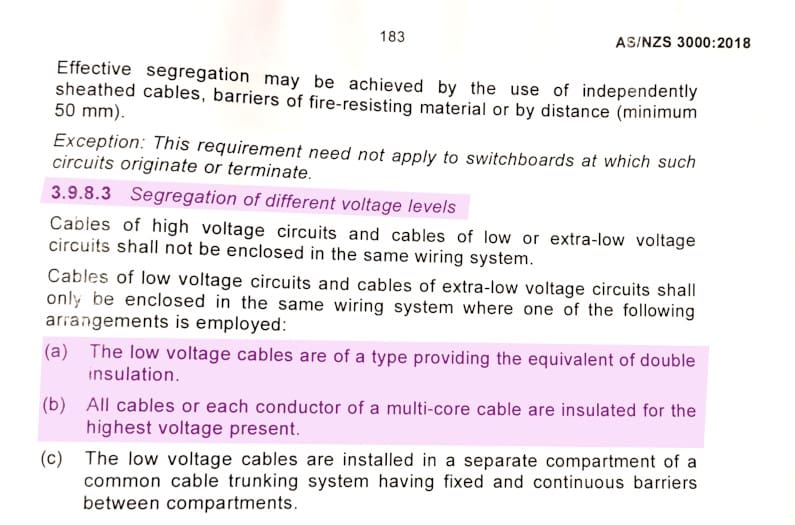
Excuses, excuses… or in this case exception (a) and (b) (image copyright Standards Australia)
So because both the cables involved are double insulated and they’re both rated for LV installation it’s quite hunky dory.
Won’t Somebody Think Of The Telecoms!
Pedants of the world will unite around AS/CA S009:2020 and excitedly point at page 80, par 16.3.1(b)
However, what they’ve failed to grasp is that the cable in question isn’t connected to a phone, so the telecoms standard doesn’t apply. Although they are different voltages. The data cable is simply part of a metering system for the EV charger.
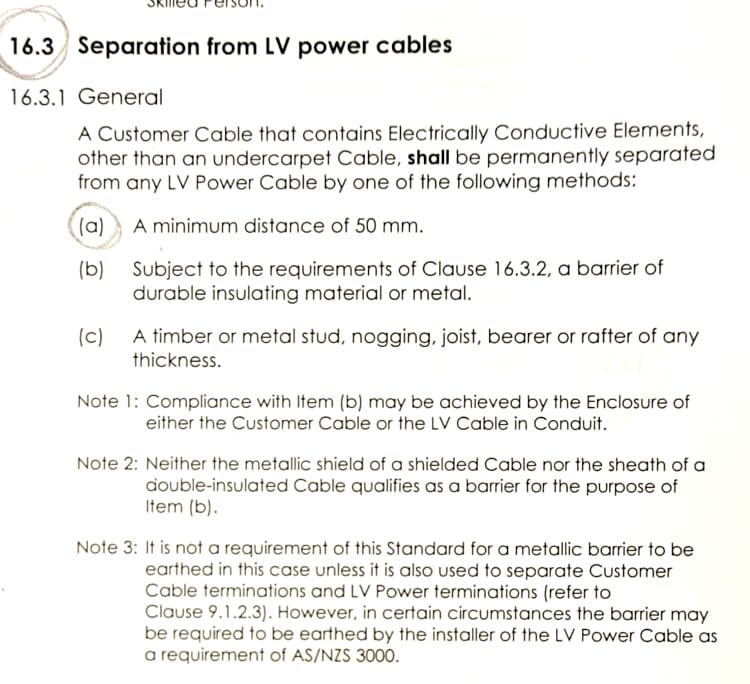
AS/CA S009:2020 is the customer cabling wiring rules for telecommunications.
Spares Fair
Now, if it was my house, I would put a spare conduit in the ground on general principle.
And I’d probably put a pink data cable in just to use as a draw wire, in case we need something else in the future.
Retail cost would be $3.95 a metre… equivalent of about 2 minutes of an electrician’s labour.
Conduit and cable are cheap as chips compared to the labour involved with digging up the yard. The key is to make sure that if there are any bends, they are very gradual. You’ll never get a new cable to slide through a conduit assembled with 90 degree elbows.
$217 for 150 metres is cheap insurance
Some years ago I built a remote area system for a high end bed’n breakfast place with two dwellings and a services shed. The 150 metres of underground was done by others, badly, but thankfully they’d run a spare data cable.
With each having four twisted pairs there was 16 strands in total. I needed 8… but during the installation they’d managed to break six in one cable and two in another.
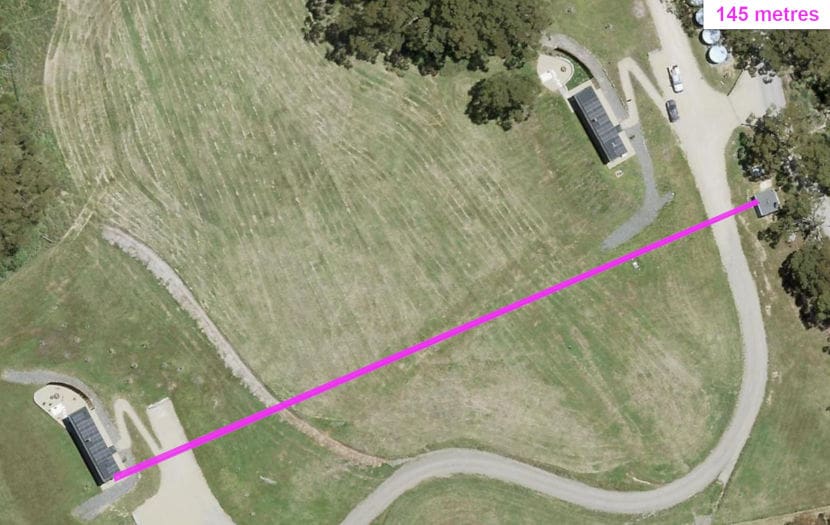
The photo doesn’t explain how steep this hill was
I was glad I took my e-bike on commissioning day. Finding the broken wires meant a dozen trips up and down the hill.
I managed to cobble them together and the system worked, but because the data was in the same conduit as the much heavier AC power cable, there was zero chance of pulling another in alongside.
Alternatives Are Wireless, Bluetooth, Cloud Tethered
Some devices, like the Fronius Wattpilot EV charger have WiFi connectivity only. Other systems can use dedicated radio links for hundreds of metres. CatchControl will even link components using WiFi over the internet.
However, when there’s a port to plug wires into, nothing beats a wired connection for speed, fidelity and reliability. In fact, there is simply no substitute for a physical link between your solar inverter and the switchboard in many cases.
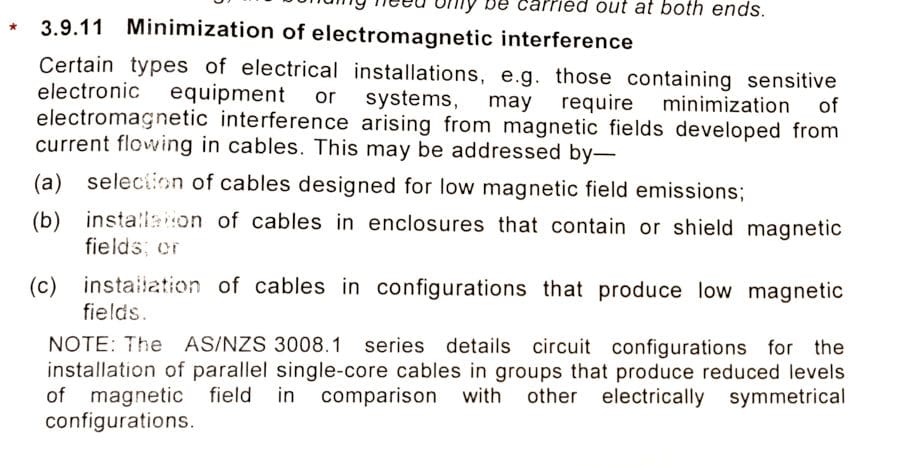
Minimising interference is quite important when you’re dealing with sensitive measurement equipment running signals alongside heavy power cables. (image Copyright Standards Australia)
Planning Makes Perfect
If you have to do some digging to install cables to your switchboard, they can go into the same wiring system, it’s economical and technically correct.
The best approach is to get quotes on the exact equipment you need. There can be specific requirements, for example, Sungrow call for 1mm² shielded twisted pair cable for RS485 consumption meters, where other brands just aren’t as fussy.
If you’re looking to the future, my advice is run a second conduit and three data cables. One for metering, one for consumption monitoring, one for internet… but if we’re being picky that might need to go into a separate white telecom conduit. And it should be placed 100mm away from the power cable in the trench to prevent electromagnetic interference.
Ring your electrician for the best advice in your particular case, I’m sure they’ll have an opinion.
For more on home EV chargers, read our comprehensive guide.

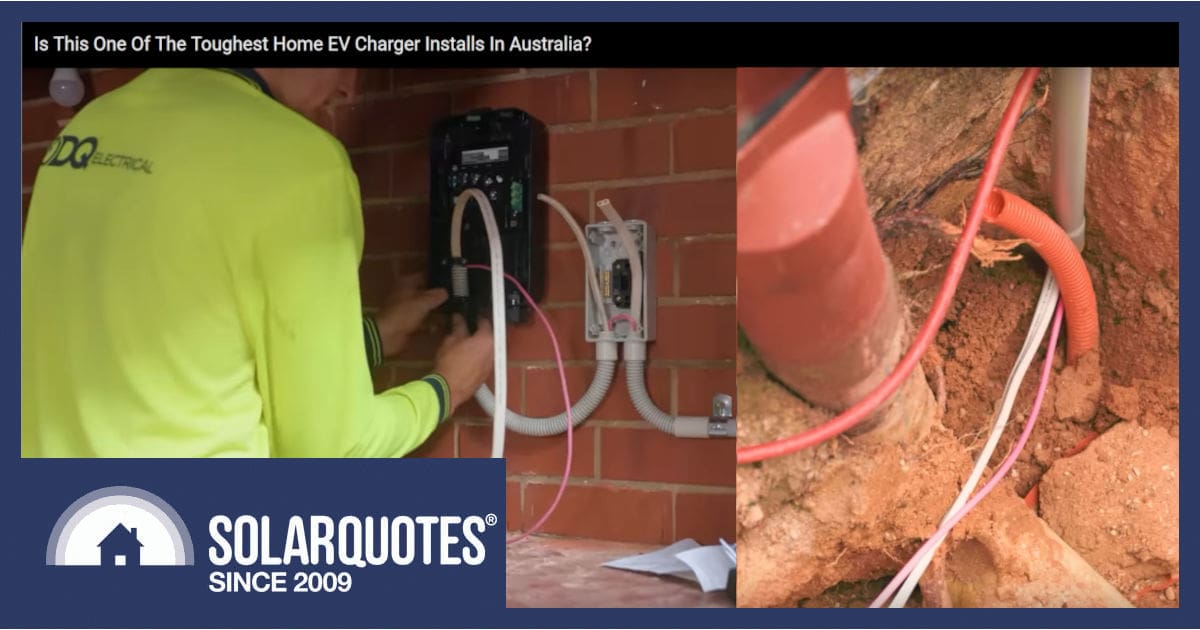
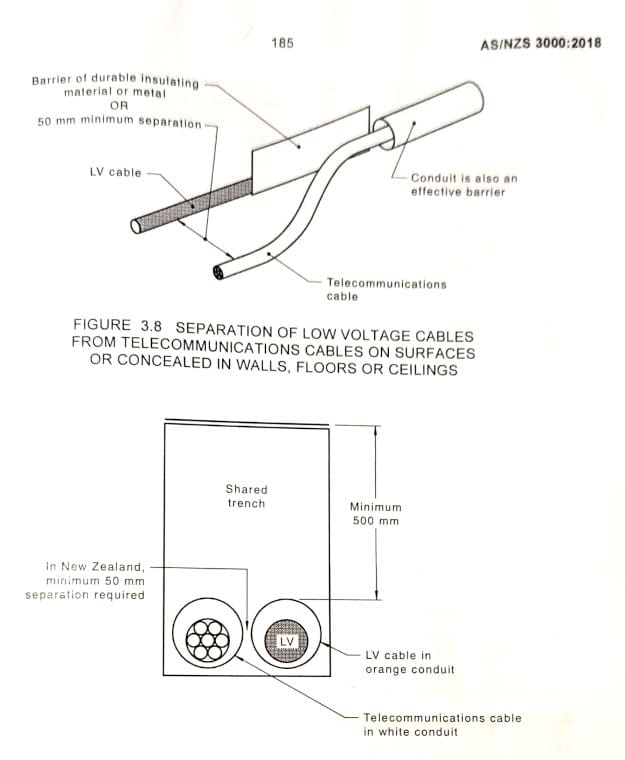
 RSS - Posts
RSS - Posts


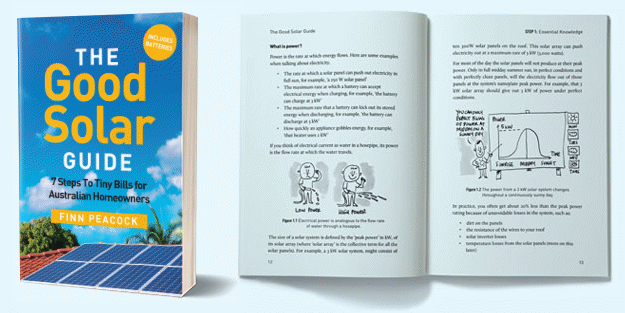
Had an electrician here yesterday assessing a pending renovation. Spent his entire visit criticising all the recent electrical work on the house by other electricians (solar and Powerwall installation and half a dozen split systems). Said the main breaker on the house will trip if we ever put all the 8 split systems on, because it’s only 64 amps.
Last time I measured the amps with all 8 on, it was under 20, and the most the property in my time has ever drawn with heating, cooking, washing and drying all going simultaneously was around 30 amps. That’s assuming P still = VI from my physics days, and the Powerwall 2 figure for total kW consumption for the house is a good measure of P. Also criticised that none of the 3 other electricians had replaced the board with one that isn’t asbestos, which I actually have some sympathy for, I believe there’s some sort of obligation on electricians to do that, if they’re working with older boards?
Evans electricians have a hierarchy. In order:
1) Industrial electricians – always follow standards, installs from HV to comms.
2) Commercial electricians – what’s HV, what’s comms?
3) Domestic electricians – 25mm2 cable, too big for me.
Domestic electricians = roof possums/house bashers
Most EV installers in the UK use EVFlex by Doncaster Cables, which has CAT6 integrated in 6mm 5 core cable. Is there an issue with Standards which prevents it from being sold and used here?
“AS/CA S009:2020 and excitedly point at page 80, par 16.3.1(b)
However, what they’ve failed to grasp is that the cable in question isn’t connected to a phone”
Indeed. And, is anything actually connected to a phone these days?
I mean a real 50-100V line, running kilometers underground to an exchange, or on “telegraph poles” that might pick up lightning strikes et c.
With the NBN-ification of everything, there are just a few in-house lines going to the modem/gateway, and maybe a lead-in to FTTC.
I reckon that standard can be deprecated. Thrown out. Purged from the pedant’s toolbox!
I live on a rural property. I have a Cat 5 cable running house to shed, only about 40M. I have had a lightning strike take out equipment even though I have some lightning protection.
Any cable over about 50M is a risk, even if buried. The problem as I see it is if a strike hits a tree or something metallic, there is a voltage gradient spreading from that tree looking for the lowest inductance path to earth, so a cable can act as a capacitor, becoming charged. The crack when it arcs over in the house is loud! (Then you look for the damaged items…)
btw, one way to leave future data/lv connection options is to bury a spare rural poly pipe in the trench. (Poly is cheap!) A pig can be blown through the pipe with a strong string. (a pig is a plug of foam that slides neatly up the pipe, with string attached. Blown by compressed air).
Doug,
When I worked on design of telecomms gear, Telstra exchanges had gaseous arrestors (gas-filled arc tubes) on external lines for first-level protection. We then had transorbs, which took the second-level kiloamps for a moment, then more protection after that.
What I’d do is replace inter-building copper with cheap fiber. Plastic will do for 40m. There’ll be cheaper interface units out there, but I’ve dealt with this mob before, and they’re local:
https://oceancontrols.com.au/ATO-300.html?srsltid=AfmBOoqgC9AcrqxPUZJDQPRG_qIwkHWxuyBtHARmChI8Sigv48CnfezV
They might also have some jacketted fibre, ready to blow through your conduit – it can’t hurt to ask. It says the unit will do 2 km. That might even be with plastic, as we did 50 km hops on glass fiber, with a matchbox-sized laser module, around 40 years ago. (OK, that was monomode fiber, not multimode – dunno how it compares these days.)
Their market is industry, so it’s not consumer grade or price there.
Anthony,
A standards discussion will bring ’em all out, m’self included, I’m afraid.
I’m not sure how non-fussy those other vendors are, but it’s seriously iffy to fail to use twisted pair for RS485, as that cheaply excludes a good bit of EMI when correctly terminated at each end. That should be around 110 ohm (120 ohm is near enough), as that matches the characteristic impedance of standard twisted pair. Controlled cable impedance and matching termination is also essential to error-free data transmission at good speed. (OK, low-speed RS485 transmitters with slowed-down trapezoidal waveforms alleviate the termination issue somewhat, if you have them, but not the EMI immunity.)
I don’t recall the cross-sectional area of CAT5, but it’s ideal for RS485, I find. (Though I haven’t taken it to the standard’s limit of a 1 km run.)
When it comes to comms reliability, I’m all for overdoing separation/shielding, even up in the ceiling – but if I’d have to dig it up again … !!
Good luck finding good electricians with that attitude towards them. It is little wonder your install did not run smooth.
So one of the reasons we use comms cable is that in general its more reliable and will have wider usable bandwidths. From back when Methusla was a boy comms cables have been twisted pairs as a very good and cheap method of noise reduction (or to put it another way to reduce the transformer coupling effect where currents in a parallel but otherwise unconnected line will induce a current in another parallel but unconnected set of lines) . Running a comms cable in parallel with a mains supply is a great way to negatively affect reliability and that wider bandwidth reason for running it in the first place. Back when I was methusla’s apprentice I was taught that comms cable and mains cable had to be physically separated as much as practically possible within the first 300mm and as much as possible where they had to cross each other then at 90 degrees to each other to minimise that transformer affect. modernCable standards are better, but bandwidths are greater. those principles still apply
I delved deeply into the data cable mire that is the Australian standards. Folk on Whirlpool or to be exact, cable installers insisted that data cables are only installed by licensed people aka them. Also the regs regarding telecommunications state that ANY data cable run in a building through ANY hole in a wall is then regarded as telecommunications even when it bloody-well isn’t connect to ANY telephone services anywhere. Even an nbn fixed wireless internet installation is according to the prehistoric rules under the jurisdiction of said regulations when no cable connects to the internet. As a sensible, retired sparky with a still working brain, I reckon some of our rules are archaic, although I do appreciate Australia does have a good safety record when it comes to low numbers of home electrocutions. Still, some of these rules need to be pulled out washed, rinsed and looked at with a 21st century eye. ‘Nough said by me but annoyed I am..
A bit off topic. But where needed point to point radios are pretty rock solid these days for ethernet and most operate as transparent bridges so other networking gear sees them as a single cable.
Also Modbus over RS485 can be converted to Ethernet and back again with simple adaptors and the likes of Fronius support Modbus TCP out the box..
For those long runs pre-term fibre with media converters is fairly inexpensive and fibre, being non-conductive can be in the same conduit as LV (and even HV for that matter) without safety concerns.
In practice twisted pair cable provides good rejection of EMF (but don’t ignore standards).
Hi Anthony,
Based on my experience (in another field) with Standards Austrelia (or whatever their name is now) I recommend that your AS extracts are labelled “Copyright Standards Australia”
Cheers
Cheers Michael,
I’ve added some acknowledgement for the lovely people at SAI Global… with some links to our opinion of them.